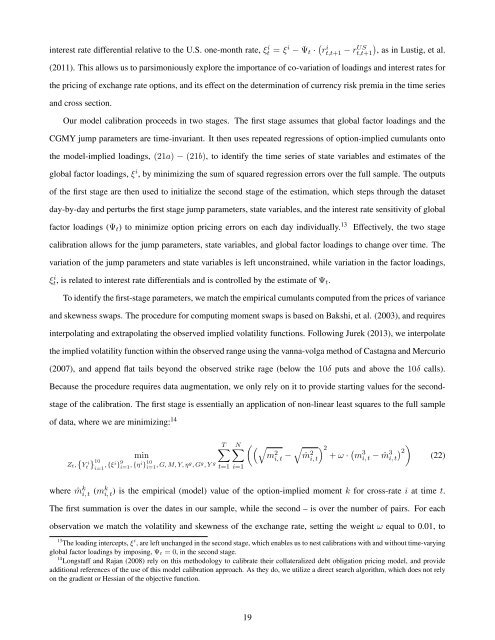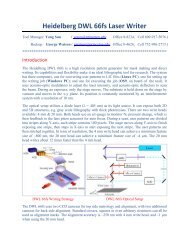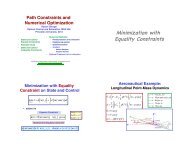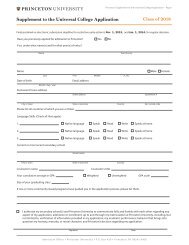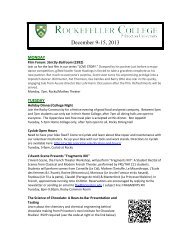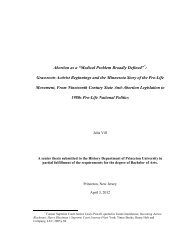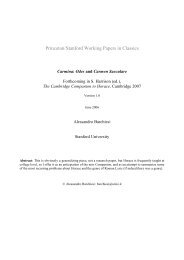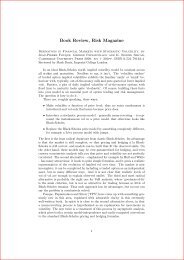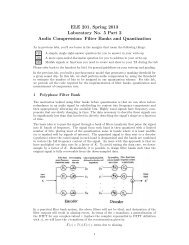Option-Implied Currency Risk Premia - Princeton University
Option-Implied Currency Risk Premia - Princeton University
Option-Implied Currency Risk Premia - Princeton University
You also want an ePaper? Increase the reach of your titles
YUMPU automatically turns print PDFs into web optimized ePapers that Google loves.
interest rate differential relative to the U.S. one-month rate, ξt i = ξ i − Ψ t · (r<br />
t,t+1 i − t,t+1) rUS , as in Lustig, et al.<br />
(2011). This allows us to parsimoniously explore the importance of co-variation of loadings and interest rates for<br />
the pricing of exchange rate options, and its effect on the determination of currency risk premia in the time series<br />
and cross section.<br />
Our model calibration proceeds in two stages. The first stage assumes that global factor loadings and the<br />
CGMY jump parameters are time-invariant. It then uses repeated regressions of option-implied cumulants onto<br />
the model-implied loadings, (21a) − (21b), to identify the time series of state variables and estimates of the<br />
global factor loadings, ξ i , by minimizing the sum of squared regression errors over the full sample. The outputs<br />
of the first stage are then used to initialize the second stage of the estimation, which steps through the dataset<br />
day-by-day and perturbs the first stage jump parameters, state variables, and the interest rate sensitivity of global<br />
factor loadings (Ψ t ) to minimize option pricing errors on each day individually. 13<br />
Effectively, the two stage<br />
calibration allows for the jump parameters, state variables, and global factor loadings to change over time. The<br />
variation of the jump parameters and state variables is left unconstrained, while variation in the factor loadings,<br />
ξt, i is related to interest rate differentials and is controlled by the estimate of Ψ t .<br />
To identify the first-stage parameters, we match the empirical cumulants computed from the prices of variance<br />
and skewness swaps. The procedure for computing moment swaps is based on Bakshi, et al. (2003), and requires<br />
interpolating and extrapolating the observed implied volatility functions. Following Jurek (2013), we interpolate<br />
the implied volatility function within the observed range using the vanna-volga method of Castagna and Mercurio<br />
(2007), and append flat tails beyond the observed strike rage (below the 10δ puts and above the 10δ calls).<br />
Because the procedure requires data augmentation, we only rely on it to provide starting values for the secondstage<br />
of the calibration. The first stage is essentially an application of non-linear least squares to the full sample<br />
of data, where we are minimizing: 14<br />
∑<br />
T<br />
min<br />
Z t, {Yt i } 10<br />
i=1 , {ξi } 9 i=1 , {ηi } 10<br />
i=1 , G, M, Y, ηg , G g , Y g t=1<br />
N∑<br />
i=1<br />
( (√ √ 2<br />
)<br />
m 2 i, t − (<br />
ˆm 2 i, t)<br />
+ ω · m<br />
3<br />
i, t − ˆm 3 ) 2<br />
i, t<br />
(22)<br />
where ˆm k i, t (mk i, t ) is the empirical (model) value of the option-implied moment k for cross-rate i at time t.<br />
The first summation is over the dates in our sample, while the second – is over the number of pairs. For each<br />
observation we match the volatility and skewness of the exchange rate, setting the weight ω equal to 0.01, to<br />
13 The loading intercepts, ξ i , are left unchanged in the second stage, which enables us to nest calibrations with and without time-varying<br />
global factor loadings by imposing, Ψ t = 0, in the second stage.<br />
14 Longstaff and Rajan (2008) rely on this methodology to calibrate their collateralized debt obligation pricing model, and provide<br />
additional references of the use of this model calibration approach. As they do, we utilize a direct search algorithm, which does not rely<br />
on the gradient or Hessian of the objective function.<br />
19


